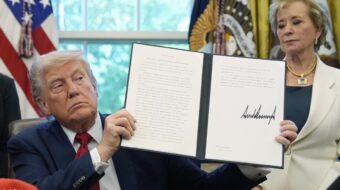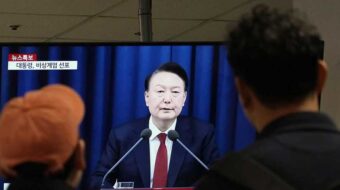NewsAnalysis
As Nicaragua prepares for elections Nov. 5, and with Daniel Ortega of the Nicaragua Triumphs/Sandinista National Liberation Front (FSLN) leading in the polls, a delegation of academics and activists is visiting the country to investigate charges of U.S. interference in the electoral process.
A delegation in June condemned U.S. interference in Nicaragua’s affairs. It noted that Paul Trivelli, the U.S. ambassador, called former President Ortega a “tiger who hasn’t changed his stripes,” and said the U.S. would “re-evaluate” its relationship with Nicaragua should the Sandinistas regain power.
Trivelli said the U.S. “will establish cordial relationships with any administration that is elected democratically … that has a reasonable economic policy and is ready to cooperate with us.”
According to the Nicaragua Network, a social justice group, the Bush administration has made it clear that this cooperation entails supporting CAFTA and other “free trade” policies; participating in all U.S. requests concerning the so-called war on terrorism; ensuring that the Nicaraguan national police receives training that blurs the time-honored distinction between civilian policing and military action; and not maintaining friendly diplomatic relations with either Venezuela or Cuba.
The United States has a history of bloody interventions in Nicaragua that spans some 150 years, and includes 11 military incursions (including a 25-year occupation by the Marines) and nearly 45 years of support for the bloody Somoza dynasty, which killed some 40,000 people. (“He’s a son of a bitch, but he’s our son of a bitch,” Franklin Delano Roosevelt famously remarked of the dynasty’s founder, Anastasio Somoza.)
U.S. interference peaked during the 1980s with the Reagan administration’s financing, arming and training of the Contras — a group of terrorists committed to reversing the Sandinista revolution of 1979 and setting off a civil war that would result in the deaths of 30,000-plus people and millions of dollars in damage to the economy.
Nicaragua, badly wounded and divided by the end of the 1980s, was then subjected to a U.S. strategy of giving “support for right-wing parties and coalitions in the 1990, 1996 and 2001 elections in order to defeat the FSLN, whilst doing all they could to discredit the left,” according to the UK-based Nicaragua Solidarity Campaign.
María López Vigil of the journal Envío remarked that outsiders “know [about the history of U.S. interference], but we feel it.”
Many people have internalized U.S. domination, she said. “Because so many efforts in Nicaragua have failed, many said, ‘Let’s not fight with them (the U.S.).’”
Washington’s current maneuvers aim at building right-center unity to block Ortega’s election. The goal is to unite those in the Sandinista Renovation Movement (MRS) and the Constitutional Liberal Party (PLC) in a coalition behind the candidacy of Eduardo Montealegre of the Nicaraguan Liberal Alliance (ALN).
Ortega is making his fifth run for office. He is mobilizing peasant farmers, women, former guerillas, students, environmentalists and intellectuals, along with some former Contra and Miskito Indian adversaries, into the Nicaragua Triumphs coalition. The coalition is calling for agrarian reform, fair trade before free trade, nationalization of key industries, health care, expanded educational and cultural opportunities, environmental stewardship, indigenous rights, gender equality and increased trade with Cuba and Venezuela.
During the Sandinista revolution, Nicaraguans organized to create a new society. “By 1983, a literacy campaign had dropped illiteracy rates from over 50 percent to 13 percent, 184,000 small farmers were given land, and vaccination campaigns and new health clinics had dropped infant mortality and raised life expectancy, leading the World Health Organization to call Nicaragua a ‘Model Nation in Health Attention,’” writes Joe DeRaymond, a longtime Latin American solidarity activist.
The red and black FSLN flag may once again flutter over this resource-rich nation, whose people remain among the poorest of Central America. The Sandinistas continue to reflect the class interests of an increasingly mobilized working poor and those who are anti-CAFTA, anti-International Monetary Fund, pro-environment and pro-democracy. Nicaragua may well be on the road to rejecting neoliberalism and embracing the continent-wide movement for self-determination and socialism, with Bolivia, Venezuela and Cuba in the vanguard.
Rosario Murillo, FSLN campaign chief and spouse of Daniel Ortega, writes: “We will win, there can be no doubt. Let us raise our hearts, our ideals and our wills. … We will triumph … the Nicaraguan people will triumph on Nov. 5! … Viva the Sandinista National Liberation Front!”









